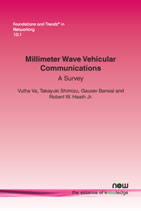Millimeter Wave Vehicular Communications: A Survey
By Vutha Va, The University of Texas at Austin, USA, vutha.va@utexas.edu | Takayuki Shimizu, Toyota InfoTechnology Center, U.S.A., Inc., USA, tshimizu@us.toyota-itc.com | Gaurav Bansal, Toyota InfoTechnology Center, U.S.A., Inc., USA, gbansal@us.toyota-itc.com | Robert W. Heath Jr., The University of Texas at Austin, USA, rheath@utexas.edu
Abstract
Future vehicles will require massive sensing capability. Leveraging only onboard sensors, though, is challenging in crowded environments where the sensing field-of-view is obstructed. One potential solution is to share sensor data among the vehicles and infrastructure. This has the benefits of providing vehicles with an enhanced field-of-view and also additional redundancy to provide more reliability in the sensor data. A main challenge in sharing sensor data is providing the high data rates required to exchange raw sensor data. The large spectral channels at millimeter wave (mmWave) frequencies provide a means of achieving much higher data rates. This monograph provides an overview of mmWave vehicular communication with an emphasis on results on channel measurements, the physical (PHY) layer, and the medium access control (MAC) layer. The main objective is to summarize key findings in each area, with special attention paid to identifying important topics of future research. In addition to surveying existing work, some new simulation results are also presented to give insights on the effect of directionality and blockage, which are the two distinguishing features of mmWave vehicular channels. A main conclusion of this monograph is that given the renewed interest in high rate vehicle connectivity, many challenges remain in the design of a mmWave vehicular network.
Millimeter Wave Vehicular Communications: A Survey
The automotive industry is at an inflection point between old and new technologies. More sensors are being incorporated into vehicles in an effort to realize safer and more efficient traffic. The increase in sensors and sensor complexity has a number of implications on the next generation of vehicles. These sensors will generate a huge amount of data that needs to be processed. This sensor data places additional computational requirements on the vehicle and requires higher data rate connectivity in the vehicle. Future systems will need to transmit anywhere from tens to thousands of megabits-per-second. Existing systems manage 6Mbps.
The large spectral channels at millimeter wave (mmWave) bands make it a promising candidate to realize high data rates. Furthermore, recent advances in CMOS technology make this cost-effective now. This monograph provides a survey on mmWave vehicular networks including channel propagation measurement, PHY design, and MAC design. The reader is given a comprehensive and up-to-date overview of the technical aspects the technology used in the automotive environment. It serves as a trusted starting point for all researchers and designers working on millimeter wave communication for vehicular applications.
